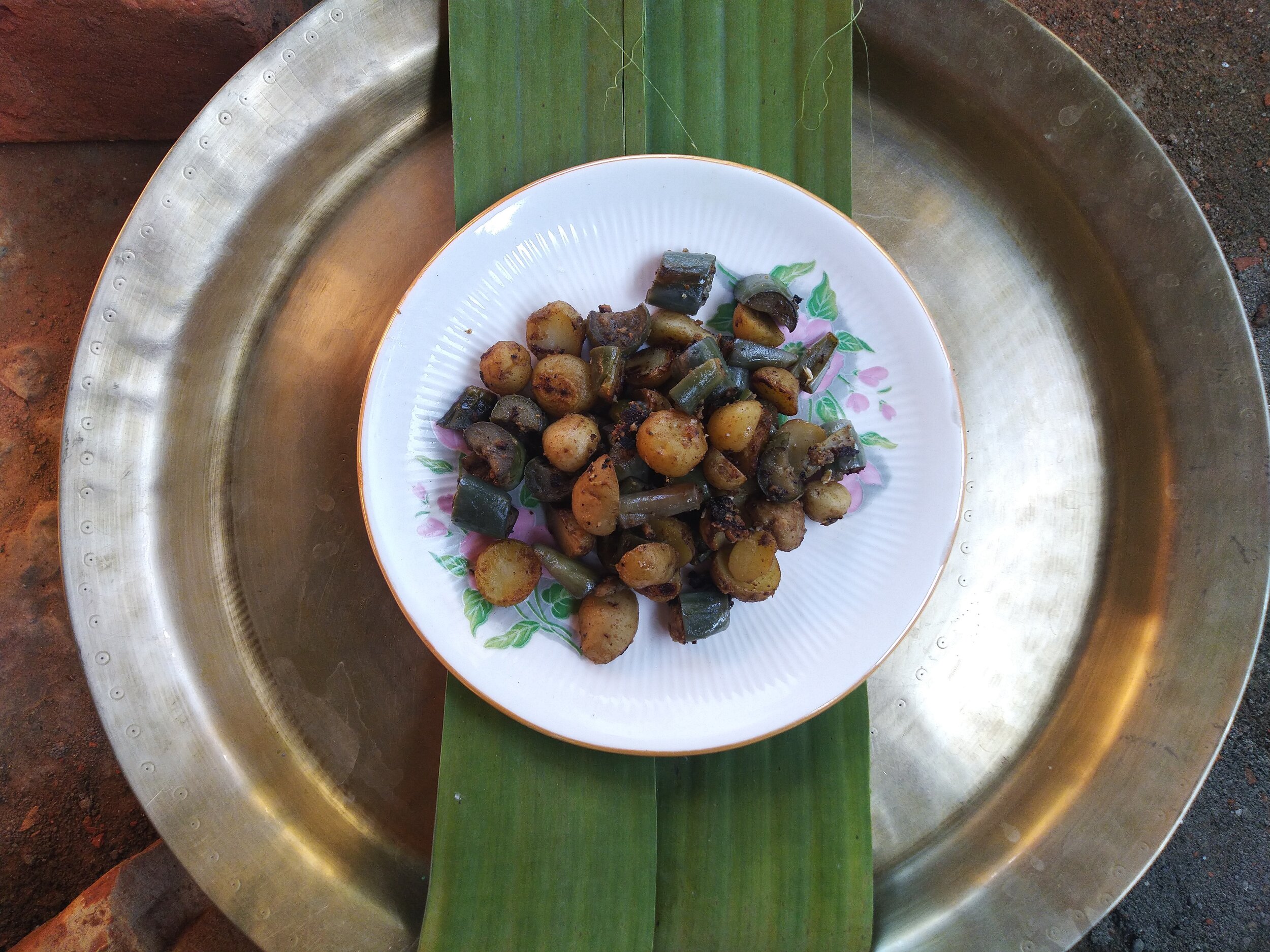An Assamese Family Recipe for Lokri

Lokri is the delicious residue of milk solids, left over from when ghee is made. This Assamese recipe, preserved only in oral tradition, uses milk solids in a delicious dish with eggplant and potato.
We understand now, that smell is an important aspect of eating. It is the distinct aroma of different flavours that create memory (and longing) in our minds. In the summer, playing in the courtyard of my ancestral home in Kharua, in Assam, my aaba (grandmother) would prepare lokri standing by her waist-high clay oven. The aroma was so intense that I’d run into the kitchen for a peek, counting the minutes to lunch. My mother inherited the recipe from her after she passed away.
Lokri is a dish native to certain parts of rural Assam, especially the region referred to as ‘lower Assam,’ where the locals speak various dialects of the formal Assamese language. The name ‘lokri’ is also a derivative, a word from the dialect spoken in parts of Baksa, Nalbari and Barpeta district, although I could not find any formal meaning or documentation of the term. It is only when I began researching this recipe that I came to understand how rare this dish has become, and that many are not even aware of it, proving its exclusive existence in the oral traditions and customs of Assam.
Lokri is a dish made from the by-product of ghee. Traditionally, ghee is made by heating milk skin, or unsweetened malai, over a pan. The milk skin, or malai, starts first bubbling and gradually separates into on the top, leaving a residue at the base. This caramelised residue, after separation, is known as lokri.
In my home, my mother stocks up milk skin and malai from home-made doi (curd) for 3-4 days. By this time, the initial stages of fermentation have set in. This adds a little sourness to the lokri. She first puts the stored milk skin and malai over an iron pan and waits for it to bubble. Once it starts bubbling, she stirs occasionally until the ghee separates from the milk skin and malai mixture, and rises to the top. By this time, the residue settles at the bottom of the pan, slowly caramelising. She then transfers the ghee into a container and lets it cool. As doe the lokri, you can eat it straight out of the pan, with a little bit of salt. It has a more intense aroma than ghee, and a mild but distinct sour tang.
But, as the pan is already laden with ghee, and the lokri left behind is such a small quantity, it is most often simply stir-fried with vegetables. In my village, I have only had lokri fried with small, oblong, purple brinjal. Cubed pieces of potato (or baby potatoes) are also added in. While there are probably several regional variations, traditionally, it is a combination of these two vegetables with lokri, as they take very little time to cook, and absorb the flavour of the lokri evenly.
In many rural households in Assam, cow milk is available in abundance. As the milk skin and malai on top of the curd are very rich in milk fats and nutrients, it is used in various traditional dishes. Perhaps these recipes were devised to store the excess milk skin and malai for longer, and to prevent it from going stale. As lokri is now rarely made, and there is almost no formal, written documentation of the recipe, I can only share here my family recipe.
Recipe: Lokri
Ingredients
½ cup stored milk skin, or malai, or both
5-6 small purple oblong eggplant (or any finger-length eggplant variety)
6-7 baby potatoes or 1 medium sized potato
Salt, to taste
Method
Stock up milk skin or unsweetened malai in a cup for 3-4 days. Usually, the malai formed over home-made curd is thicker and requires less time to reach the desired quantity.
Transfer it to a pan and place it over medium heat. Once it starts bubbling, keep stirring occasionally until the ghee separates and rises to the top.
Skim the ghee out into a container and let it cool.
The caramelised residue at the bottom of the pan is what we call lokri.
At this stage, you can have it with a sprinkle of salt or you can fry it with the vegetables mentioned above.
For the vegetable fry, toss the finely chopped smaller finger-length eggplants into the pan along with chopped baby potatoes or a cube-cut medium sized potato.
There is no need to add any oil as the pan is already laden with ghee. Cover the pan until the vegetables are cooked.
Add salt as per taste and stir fry until the potatoes are golden brown.
The lokri will look grainy at the end, and the vegetables absorb the intense aroma. Serve it as an accompaniment to rice.
Variations: Regional variations may exist in terms of choice of vegetables. Some may even have it with curry or as a side dish like chutney.
Words and photographs by Simanta Barman. You can reach him here.
ALSO ON GOYA JOURNAL









